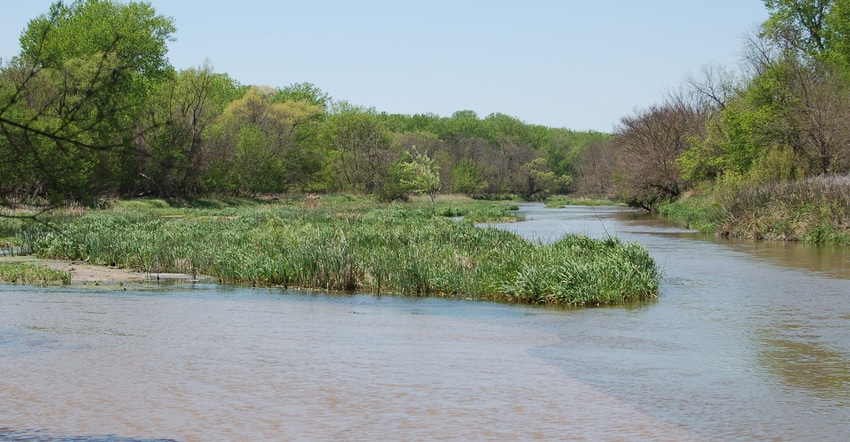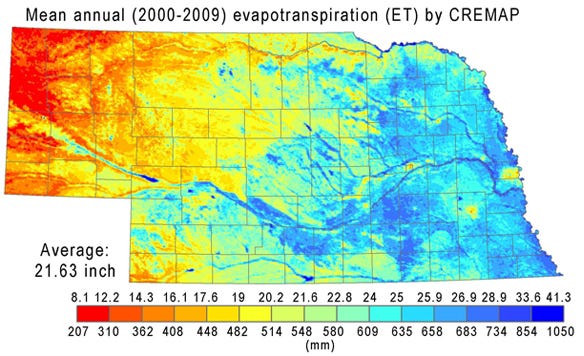
This article is the latest in a series of articles discussing water consumption and use from a supply perspective and as it relates to watershed management concepts. This series will be produced in connection with the Nebraska Water Balance Alliance (NEWBA) and several of its associates.
It's no surprise Nebraska's name comes from an Otoe word meaning "flat water" — so named for the Platte River that runs the length of the state. Nebraska boasts more miles of river than any other state. And although these areas only make up a fraction of a percent of the state's total area, riparian areas have been the subject of numerous studies and discussions when it comes to managing evapotranspiration (ET).
In previous articles in this series, we've discussed value propositions in managing consumption at different scales. This means weighing the benefit of high-value consumption like drinking water and irrigating crops, and competing consumptions like direct evaporation, and managing competing consumption in a way that's beneficial. One example may be reducing non-beneficial ET in riparian areas.
In some cases, heavily forested riparian woodlands in Nebraska may even have higher ET levels than nearby open bodies of water. That is, the plants transpire more water than would be evaporated in an open body of water. However, ET in riparian areas isn't well understood, and there are several components driving how much water transpires and evaporates in riparian areas.
"Water that lands in a riparian area still performs like water in uplands in that some of it evaporates and some of it becomes available to the plants," explains Dave Rus, hydrologist at the U.S. Geological Survey's Nebraska Water Science Center. "What's different is riparian areas also have shallow groundwater, and plants can react differently to having that resource available."
Factors affecting ET
The closer the water table is to the surface, the easier it is for water to evaporate through the soil, and the closer water is to the roots, the easier it is to transpire through the plant. In some riparian areas in Nebraska, the water table may be as shallow as 24 inches from the surface.
So, it's commonly believed riparian vegetation uses water at or near the maximum ET rate due to the availability of surface water and shallow groundwater for transpiration and photosynthesis.
However, a study conducted by Rus and other USGS researchers from 2002 to 2005 indicates this may not always be the case. Throughout the four-year period, actual ET measurements taken from riparian woodlands along the Central Platte River were generally 50% or less of the estimated maximum reference ET. It's hard to say why exactly the actual ET was lower than expected, but it may be due to several factors.

Estimated annual ET rates in Nebraska for 2000-09. In some cases, heavily-forested riparian woodlands in Nebraska may have higher ET levels than nearby open bodies of water. (Map courtesy of Jozsef Szilagyi, UNL)

Some plants are more water-use efficient than others and require less water to grow biomass — and biomass plays a role in several ways. Certain plants provide shade that can prevent evaporative losses to a certain extent. Plants regulate transpiration based on climatic factors like solar radiation, relative humidity and wind activity — in addition to water availability, as previously mentioned.
"It's a balance of multiple factors, drivers and barriers to ET," says George Burba, principal scientist and technical group leader in Li-Cor's research and development department, and a Global fellow at Daugherty Water for Food Institute at UNL. "There is a sweet spot for each ecosystem, for each geographical location. The first thing you want to know is how water use efficient the species in the riparian area are."
Certain drivers affecting ET (like climate or sunshine) can't be changed, but landowners and managers can put obstacles in place to mitigate undesirable ET through invasive or even native vegetation.
Managing undesirable ET
One way this could be accomplished is by temporarily taking water away from riparian vegetation rooted in an alluvial aquifer during periods of peak ET — such as July and August — by lowering the groundwater table.
This would cause native trees to go dormant, and give a chance to add water to the stream when it's most necessary or valuable. This process could help positively retime streamflow, increase the total water supply through ET salvage, and shift lower-value consumption to higher-value opportunity. The alluvial depletion can naturally recharge later on in fall and spring when streamflow is generally less critical. Of course, this practice would also need to meet or address all existing regulations and state statutes.
"It might be practical and beneficial to identify appropriate places in an alluvial aquifer with the highest ET and the largest most densely vegetated areas, especially above-stream segments with higher expectations and a need for reliable flow, then design a well field or other dewatering system to lower the water tables in those areas and directly discharge this water into the adjacent stream," explains Frank Kwapnioski of H2Options Engineering LLC and NEWBA adviser. "You may only need to lower the water table several feet to cause this riparian vegetation to go dormant during the highest ET period of the year, and the discharged water could additionally help reduce flow shortages."
Why not just remove this vegetation? Remove existing vegetation can be very expensive. In addition, if all the vegetation is removed and prevented from growing, the soil is exposed to direct sunlight and wind, which means increased evaporation — not to mention erosion.
Although lowering the water table hasn't specifically been tested in areas with riparian vegetation before, the practice would be similar to dewatering an area for a construction project.
Of course, the only way to understand whether managing the water table has the desired effect on ET and streamflow is by measuring. This is where automated tools like Li-Cor's eddy covariance ET stations can come in, providing a method to measure ET in real-time. "By directly measuring ET with high precision, if you change management, and you save water, you will see it in the data," says Burba. "You will know what happened and whether your management had the desired effect."
About the Author(s)
You May Also Like




